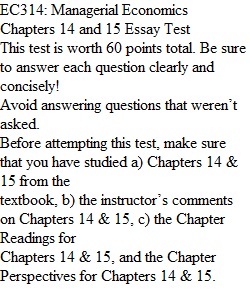


Q EC314: Managerial Economics Chapters 14 and 15 Essay Test This test is worth 60 points total. Be sure to answer each question clearly and concisely! Avoid answering questions that weren’t asked. Before attempting this test, make sure that you have studied a) Chapters 14 & 15 from the textbook, b) the instructor’s comments on Chapters 14 & 15, c) the Chapter Readings for Chapters 14 & 15, and the Chapter Perspectives for Chapters 14 & 15. Chapter 14: Challenges of behavioral economists A. According to the textbook, all the books cited by the authors as being written from the behavioral economics viewpoint “carry two levels of argument.” Explain what they are.(4) B. Behavioral economists cite a number of different ways in which (based on experiments) people fail to make the kinds of decisions that they would make if they were perfectly rational. Here are some of them. For each one, explain what behavioral economists have found and the nature of the challenge those findings pose for traditional economics. 1. Loss aversion (6) 2. Endowment effect (6) 3. Mental accounting (framing) (6) C. What are “financial market bubbles” and what problem do they pose for traditional financial economics? How do behavioral economists explain such bubbles?(10) Chapter 15: Problems with behavioral economics A. Many economists believe that you cannot judge the usefulness of a theory based on the realism of its assumptions, and so the standard assumption that people are motivated by “rational self-interest” should not be dismissed so easily. Yet behavioral economists claim to have solid evidence that contradicts the assumption of “perfect” rationality. But the authors of the textbook dispute the validity of that evidence. For each of the following, briefly explain their arguments: 1. The reliance on laboratory studies (6) 2. The human brain’s internal inclination to correct bad decisions (6) 3. Errant decisions, entrepreneurs, and market pressures (6) B. In part B of the chapter, the authors discuss “nudges” that have been proposed by behavioral economists. Choose two nudges from among those suggested. Explain how they are supposed to work, and then offer your assessment on whether, based on the analysis presented in the book and the Instructor Comments, they would be a good or bad idea. (10)
View Related Questions